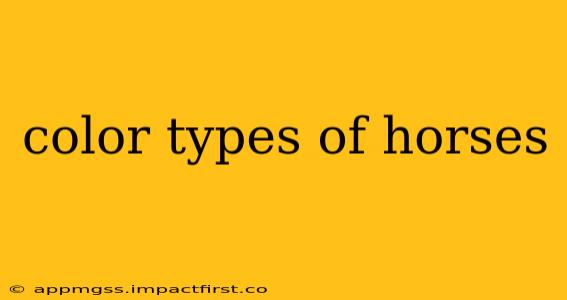Horses, majestic creatures known for their beauty and strength, boast a remarkable diversity of coat colors. Understanding the genetics and terminology behind these colors can be fascinating for both seasoned equestrians and casual admirers. This comprehensive guide will delve into the various color types of horses, exploring the underlying genetics and distinguishing features of each. We'll also address some frequently asked questions about horse coat colors.
What are the Basic Horse Coat Colors?
The foundation of horse coat color lies in just a few basic colors, which then interact with various genes to create the stunning array of colors we see today. These basic colors include:
- Bay: A bay horse has a reddish-brown body with a black mane, tail, and lower legs. The shade of red can vary significantly, ranging from light chestnut to a dark, almost mahogany hue.
- Black: A true black horse has a completely black coat, mane, and tail. However, it's important to note that many horses appear black but might actually be a very dark brown or a diluted color.
- Chestnut (Sorrel): Chestnut horses range in color from a light, golden shade to a deep, reddish-brown. Their mane and tail are generally the same color as their body.
- Grey: Grey horses are born with a color other than grey (often dark) and gradually lighten with age, usually becoming completely white by maturity. The process is not an actual change in hair color but the production of progressively more white hairs.
What are Diluted Colors in Horses?
Dilution genes are responsible for lightening the base coat color, resulting in a variety of beautiful and unique shades. These include:
- Cremello: A very pale cream color, often with pink skin and blue eyes. This is a double dilution of chestnut.
- Palomino: A golden coat with a flaxen (light blonde) mane and tail. This is a dilution of chestnut.
- Buckskin: Similar to palomino, but the body color is usually more of a tan or buckskin shade rather than golden. The mane and tail are flaxen. This is a dilution of bay.
- Perlino: A very light cream color, similar to cremello, but often resulting from the dilution of a bay base.
- Smokey Black: This is a black horse with subtle dilution, appearing slightly brownish or faded.
What are Other Notable Horse Coat Colors?
Beyond the basic and diluted colors, several other notable coat colors exist, often resulting from complex interactions between multiple genes:
- Roan: Roan horses have a mixture of white and colored hairs throughout their coat, giving them a mottled appearance. There are different types of roan, including red roan, bay roan, and blue roan.
- Dun: Dun horses have a base coat color that is usually yellowish or tan with a dark dorsal stripe (a stripe running along their back) and zebra stripes on their legs.
- Grullo: A very dark, almost mouse-grey color, typically with a dun factor present.
What are the Different Types of White Markings on Horses?
White markings are distinct from coat color and are often used for identification. Common white markings include:
- Star: A small white marking on the forehead.
- Stripe: A white marking running down the face.
- Blaze: A broad, white marking running down the face.
- Snip: A small white marking on the muzzle.
- Sock: A white marking on the lower leg.
- Stocking: A white marking extending higher up the leg than a sock.
How are Horse Coat Colors Inherited?
Horse coat colors are determined by a complex interplay of multiple genes. These genes interact in various ways, leading to the diverse range of colors and patterns we observe. Understanding the genetics behind these colors is an ongoing area of research, but significant progress has been made in identifying the key genes involved.
Can a Horse Change Color?
While a horse's base color generally remains consistent throughout its life, a horse's coat color can appear to change due to seasonal shedding, sun bleaching, and the gradual lightening of grey horses. However, true color change, in terms of genetic alteration, is not possible.
This guide provides a comprehensive overview of the diverse range of horse coat colors. While there is always more to learn about the complexities of equine genetics, this information provides a solid foundation for appreciating the incredible variety of colors and patterns found in these beautiful animals.
